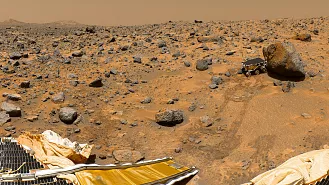In a startling revelation that has rekindled interest in extraterrestrial life, a former NASA employee has asserted that evidence of life on Mars was discovered as early as 1970. This claim, made by Dr. Gilbert Levin, who worked on NASA’s Viking program, has sparked renewed debates among scientists and space enthusiasts alike regarding the potential for life beyond Earth.
Dr. Levin, who served as the principal investigator for one of the Viking lander’s experiments, revealed that the mission’s findings provided strong indications of biological activity on Mars. The Viking landers, which were launched in 1975 and landed on Mars in 1976, were tasked with conducting various experiments to determine the presence of life on the Martian surface. According to Levin, one particular experiment, designed to detect metabolic processes in Martian soil, yielded unexpected results.
In an interview, Levin stated, “The data from the Viking landers showed that something was metabolizing the nutrients we provided. We observed reactions that suggested the presence of microbial life.” He emphasized that the scientific community largely dismissed these findings at the time, attributing them to chemical reactions rather than biological processes.
Levin’s claims have gained traction as advancements in technology and ongoing missions to Mars continue to explore the planet’s surface. The growing body of evidence, including recent discoveries of water and organic molecules, has led many researchers to reconsider the potential for past or present life on Mars. Levin argues that the findings from the Viking missions should not be overlooked and warrants further investigation.
Critics, however, caution against jumping to conclusions. While Levin’s assertions are provocative, many scientists maintain that more rigorous evidence is needed to definitively claim the existence of life on Mars. The complexities of life detection and the need for corroborative evidence have led to a cautious approach within the scientific community.
As Mars exploration continues with missions such as NASA’s Perseverance rover and the European Space Agency’s ExoMars program, the quest to uncover the planet’s secrets is more active than ever. These missions are equipped with advanced instruments designed to search for signs of past life and collect samples for future analysis.
Dr. Levin’s claims have reignited public interest in the possibility of life on Mars, reminding us of the mysteries that still lie beyond our planet. While the scientific community remains divided on the interpretation of past data, the pursuit of knowledge about life beyond Earth continues to drive space exploration.
In conclusion, the assertion by former NASA employee Dr. Gilbert Levin that life on Mars was proven in 1970 has reignited discussions about extraterrestrial life. As current missions work to unlock Mars’ secrets, the quest for understanding our universe and the possibility of life beyond Earth remains a captivating endeavor. Whether Levin’s claims will ultimately be validated or debunked, the exploration of Mars continues to inspire curiosity and hope for future discoveries.
